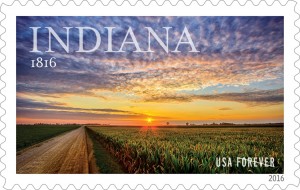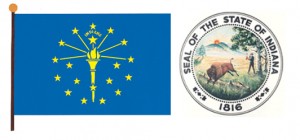Indiana Turns 200
December 9, 2016
Sunday, December 11, is the bicentenary of the Midwestern state of Indiana. Looking back 200 years to 1816, when Indiana became the 19th state in the Union, many people may be surprised that statehood did not come easily. Aside from convincing the U.S. Congress to accept Indiana as a state, there were some Hoosiers themselves that needed convincing.

A commemorative stamp celebrating Indiana’s 200th birthday features a sunset over cornfields near Milford in northern Indiana’s Kosciusko County. Credit: United States Postal Service
Many people were perfectly happy living in the Indiana territory and wanted nothing to do with the trappings of statehood. Some feared the higher taxes that came with statehood, as well as an increase in laws and regulations. Chief among the “just say no to statehood” faction was William Henry Harrison, the champion of Tippecanoe in 1811 and appointed (not elected) governor of the Indiana territory (as well as a future U.S. president). Harrison stood to lose considerable, almost dictatorial powers if the territory became a state. Statehood would also mean the abolition of slavery in Indiana, a practice many conservative landowners wanted to preserve.

Indiana’s state flag, at left, adopted in 1917, has a torch that stands for liberty and enlightenment. The 19th and largest star above the torch represents Indiana, the 19th state. The state seal, at right, adopted in 1963, shows a pioneer scene. Credit: World Book illustrations
A majority of Hoosiers, however, favored statehood and its democratic benefits, as well as its increased protection. Indiana was on the western frontier in the early 1800’s, and violence often overruled territorial statutes and ordinances. Hostility between Native Americans and settlers continued, too, as ever more of Indiana’s fertile soils were claimed for farming. The introduction of federal laws—as well as federal troops—would do much to calm Indiana’s frontier turbulence. Hoosiers also wanted the hospitals, schools, transportation, and other far-reaching benefits of statehood. Additionally, Indiana settlers wanted to elect a governor with limited power. Last, but perhaps most important, most Hoosiers wanted slavery to be outlawed.
The Indiana Territorial Assembly listened to the Hoosier majority and petitioned for statehood in late 1815. Congress approved the petition the next year, and President James Madison signed it into law.


